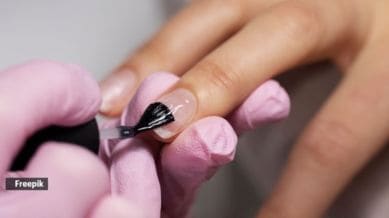As Europe bans gel nail polish, what should you be checking at your salon? Here’s a dermatologist guide
Many users report sensitivity after repeated use. UV exposure matters too

Your manicured, painted nails might just impact your health and wellbeing. The European Union (EU) has banned a key ingredient found in gel nail polish, instructing nail salons to safely dispose of their existing stock and asking manufacturers to roll out products without it.
The compound under the lens is Trimethylbenzoyl Diphenylphosphine Oxide (TPO). This reacts under UV and LED light to harden your nail polish quickly and give it a glass-like finish. The EU order follows several studies linking TPO exposure to toxicity, skin irritation, fertility issues and damage to cell DNA, sparking concerns about its cancer-causing potential.
Why is a nail gel compound under the scanner?
TPO is capable of releasing reactive compounds that can irritate the skin, eyes and respiratory system. Prolonged exposure to TPO may even cause contact dermatitis, allergic reactions, and in some situations lead to immune system disruption.
When a gel polish includes TPO and it is applied, some TPO may be in direct contact with the surrounding skin. An allergic reaction could result in redness, itch, or peeling of the skin surrounding the nail. Over time, the TPO chemical may become trapped under the nail and on the nail, leading to brittle nails and discoloration. Salon workers exposed to these TPO products and not taking protective measures, undeniably have a higher chance of experiencing persistent irritation and subsequent allergic sensitization.
The UV exposure matters too
The curing process involves UV (ultraviolet) or LED lamps. These lamps do not just cure TPO (hardening the layer) but they also expose users to ultraviolet radiation. Repeated exposure, particularly when users do not wear protective gloves when using gel products, may be a risk for early aging and possibly skin cancer. Provided this is done occasionally, it is probably not an acute danger. However, regular gel manicures certainly increase risk.
Does it impact salon professionals?
Though these reactions often occur with professionals in the industry, everyone using products with TPO could experience wide-ranging health issues in the future. If you think about how chemicals can move across dermal barriers in the skin over time, repeated or prolonged interactions with TPO products could exacerbate these outcomes.
What should you watch out for before applying a gel polish?
Read the ingredient label to make sure that the gel polish does not contain TPO. If you notice TPO, do not buy it. It is best to use TPO-free or 3-free and 5-free gel polishes to lower your risk. There are alternatives but they too have allergens. Traditional nail polish is a good alternative. It requires frequent touch-ups but is less likely to cause allergic reactions.